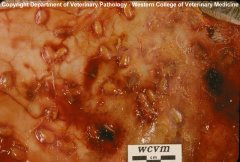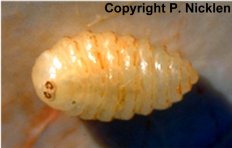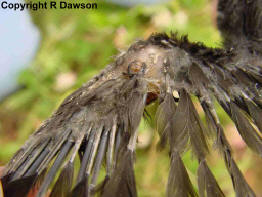|
|
|
| Causative Agent |
-
Mammals, birds and livestock are prone both to the bites and larvae of
several species of flies that feed on flesh, blood or secretions.
-
The main groups that are important for wildlife are:
-
Calliphorid flies - common
examples include bluebottle and greenbottle flies, and bird blow
flies;
-
Bot and warble flies (Cuterebrinae and
Hypodermatinae) - common examples include bot flies of
rodents;
-
Nasal and pharyngeal bot flies (Oestrinae) -
common examples include the nasal bot fly of caribou
(Rangifer tarandus).
|
| Images |
|
Click on images to enlarge. |
 |
 |
 |
|
Larval warble fly
underneath the skin of a caribou. |
Close-up of a larval warble fly. |
Larval blow flies that
parasitize nestling birds often cling to featherless areas of
the bird, while some species embed in tissues. |
|
| Distribution |
|
Geographic: |
-
In most areas of North America.
|
|
Seasonality: |
-
Dependent on species; throughout the year in southern regions.
|
|
| Hosts and Life
Cycle |
| Calliphorid flies: |
-
Eggs are laid on wounded skin, infected skin, or skin soiled with feces.
-
Larvae feed within the wounds and then drop to the ground to develop into
adults and continue the cycle.
-
Female bird blow flies (Protocalliphora) lay eggs in nests of birds, and the larvae live
within the nesting material, feeding intermittently on the
blood of nestlings. One species (Trypocalliphora
braueri) burrows under the skin of nestling birds, often
with detrimental consequences.
|
|
Bot flies: |
-
In North America, bot flies typically parasitize rodents and rabbits.
-
Female flies deposit eggs at entrances to burrows and other areas
frequented by hosts.
-
Eggs hatch in response to cues generated by the host (e.g., increased
environmental temperature, carbon dioxide and moisture from
the host).
-
Hatched larvae gain entrance to the host through the mouth, nasal
openings or cuts in the skin. In infected rodents, larvae
are commonly located in the region of the groin but may also
occur beneath the skin on other parts of the body such as
the neck.
-
In
cervids such as caribou, the adult
fly lays eggs on the hairs of the caribou’s legs and lower
body. Hatched larvae penetrate the skin, and travel under
the skin to the caribou’s back where they mature.
-
Larvae develop under the
skin until late summer at which time they emerge from the
host through a breathing pore in the skin called a
warble.
-
Newly hatched larvae measure
from 2 to 4 mm long and are grayish-white; larvae mature to
a dark brown color just prior to emergence from the host.
Fully grown larvae will measure from 20 to 42 mm in length
and up to 7 to 10 mm in width.
-
Pupation (development into
the adult stage) occurs in the soil and the fly over-winters
in the pupal stage.
-
Adults emerge in summer and
will mate and lay eggs within a few days.
|
|
Nasal bot flies: |
-
In North America, the larvae of nasal bot flies are found in the nasal
passages and throat pouches of
cervids such as caribou, moose,
elk, white-tailed and mule deer as well as bighorn sheep.
-
Female nasal bot flies
deposit larvae into the nostrils of the host during hot days
of summer where early stages of larval growth take place.
-
After a short period, larvae
move to pouches that lie on either side of the throat at the
base of the tongue where further growth takes place.
-
Fully developed larvae are
about 25-36 mm in length and, at maturity, are expelled from
the throat to pupate in the soil. Adults emerge from the
soil 2-3 weeks later.
-
Nasal bot flies overwinter
in the larval stage within the
cervid host.
|
|
| Signs and Symptoms |
| Calliphorid flies: |
-
Fly larvae can cause direct damage to tissues which may also lead to the
development of secondary infections from bacteria.
|
|
Bot flies: |
-
The early stages of infection by bot flies are rarely evident from the
outside, and often are only detected by touch or after
sufficient growth has occurred so that they are visible.
-
In smaller mammals, such as chipmunks, the larvae often produce an
obvious awkwardness in locomotion, which may render them
more susceptible to predation.
-
As with Calliphorid flies, wounds made from bot fly larvae may become
infected with
bacteria.
-
Paralysis
and death may occur in
rodents or rabbits
if the larvae migrate through the brain or spinal cord.
-
Animals infected with
warbles usually appear healthy, although those with heavy
infections may appear weak and there may be damage to the
hide quality. While laying their eggs, warble flies harass
animals and interfere with feeding.
|
|
Nasal bot flies: |
-
Larvae or "bots" can cause
inflammation and
edema, occasionally leading to
local damage or to
pneumonia. Difficulty with breathing
may result when the infestation is particularly heavy.
-
Nasal bot flies cause
annoyance to cervids that can lead to loss of body condition due to
inadequate feeding. Animals under attack generally cluster,
or may become nervous or panic-stricken, even stampeding.
-
Larvae often cause local
inflammation in the infected pouches.
|
|
| Meat Edible? |
-
The meat of animals infected with larvae is considered safe for human
consumption following removal of any affected tissue. Animals in
poor condition are likely to have poor-quality meat.
|
| Human Health Concerns and
Risk Reduction |
-
Some Calliphorid flies can be annoying pests of humans, and may
occasionally invade human tissues.
-
There are cases reported worldwide of nasal bot fly larvae infecting the
eyes of humans.
-
There are occasional reports of bot flies infecting humans. These cases
tend to occur during late summer, incidental to outdoor activities,
when adult flies are most numerous.
|
| Samples for Diagnosis |
-
Collection of the flies or pupae is sufficient for diagnosis.
|
| Further Reading |
|
|
|
|


